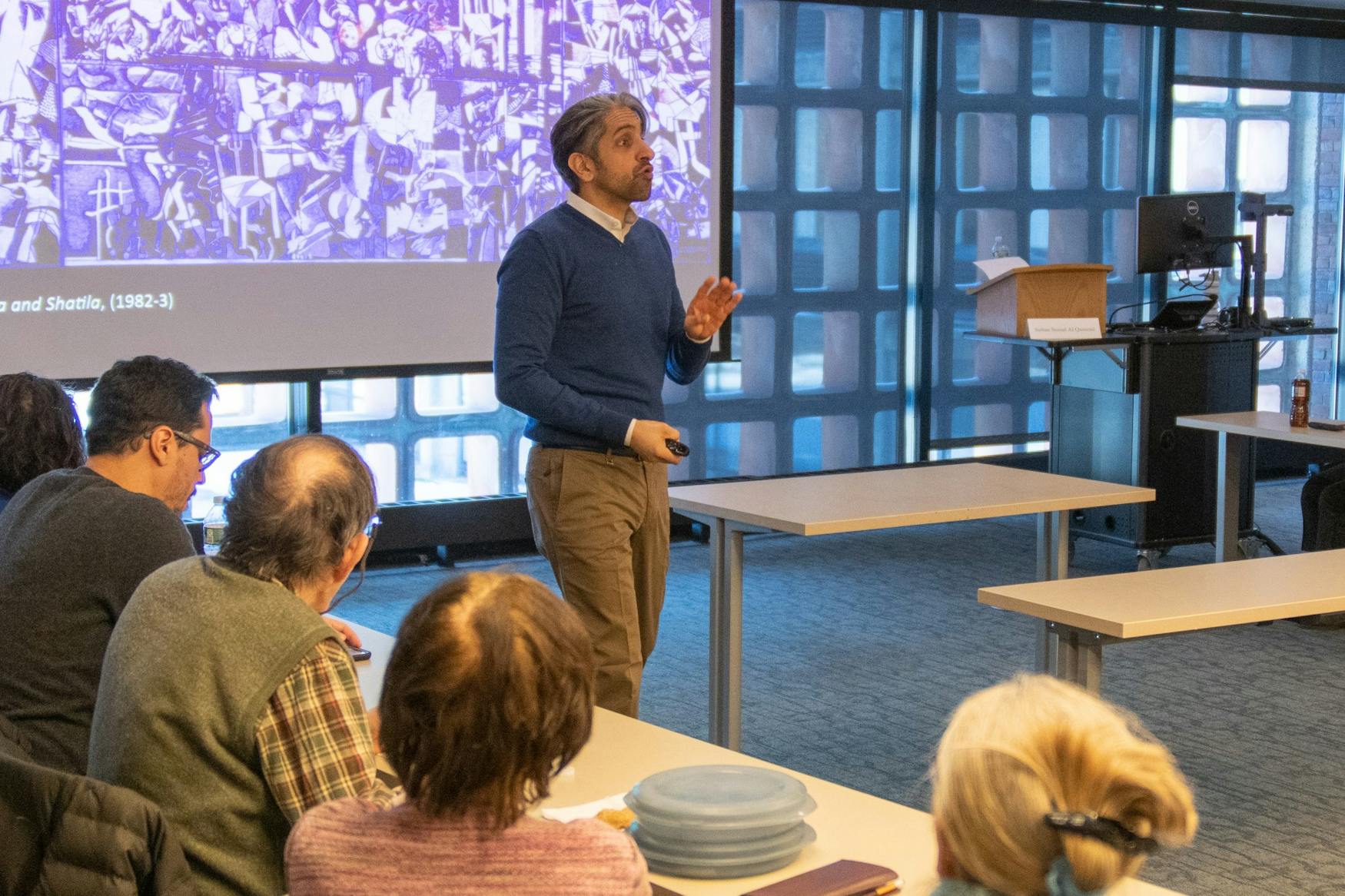Expert explores intersection between politics and art in the Middle East
Expert explores intersection between politics and art in the Middle East
Writer, Boston College professor and art collector Sultan Sooud Al Qassemi spoke about how modern art from the Middle East interacts with politics during a talk on Wednesday hosted by the Crown Center for Middle East Studies.
Al Qassemi showed photographs of art that was created in response to the formation of the state of Israel back in 1948. A national identity for Jews began to emerge, Al Qassemi said, and Israelis started “presenting themselves as conquerors.” For example, Israeli artist Marcel Janco painted “Death of the Soldier” in 1949, a painting which depicts a group mourning an Israeli soldier, with Jerusalem looming in the background. The soldier’s face is bathed in light from the sky. This painting, according to Al Qassemi, came before Israelis would have a national art identity and style, approximately 30 years later.
At the same time that Israelis were creating art that romanticized Israeli militarism, Palestinian artists were creating art in response to the poverty and displacement they faced as a result of the creation of the state of Israel, Al Qassemi explained. Ismail Shammout was one Palestinian artist doing so. He painted “Where To?” in 1953, which shows a displaced Palestinian family trying to find somewhere to go. Dia Azzawi painted what Al Qassemi called the “Palestinian ‘Guernica’” in 1982 and 1983, called “Sabra and Shatila,” which was also the name of a refugee camp. In 1982, a group of soldiers from the South Lebanon Army, which was closely allied with Israel at the time, invaded this camp and killed approximately 2,000 people. People learned about this attack largely through radio, so Azzawi’s work was one of the only visualizations of the incident, Al Qassemi elaborated.
Al Qassemi explained that other Middle Eastern artists created works that showed solidarity with Palestinians. Naim Ismail, a Syrian artist, painted “Fedayeen” in 1969, which depicted Palestinian freedom fighters. However, Al Qassemi said, some of the works depicted Jews as the enemy rather than Israelis. “Some of [the paintings] really bordered on the anti-Semitic, only because they didn’t know how to differentiate or distinguish between Israel [and] Judaism,” he said.
As an example, he presented “A Palestinian Scene” by Samir Rafi, which displays a group of soldiers wearing the Star of David while pointing guns at a group of civilians.
At the same time, Al Qassemi explained, some Israeli artists used their work to express solidarity with Palestinians. Naftali Bezem created “In the Courtyard of the Third Temple” in 1957 in response to an Israeli attack in 1956 that killed “about three or four dozen Palestinians,” according to Al Qassemi. “Even Israelis had [objections] to policies that were taking place,” he said.
Violence in Algeria also inspired Middle Eastern art. In response to the Algerian War of Independence against France, an Amazigh artist named M’hammed Issiakhem created “Les Martyrs” in 1965. This was another Middle Eastern painting that Al Qassemi said exhibited “Guernica” influence. He added that Moroccan and Iraqi artists created art in solidarity with Algeria as well.
Middle Eastern artists were also interacting with politics in other areas of the world, Al Qassemi said. For example, Ibrahim El Salahi painted “Funeral and the Crescent,” which depicted Patrice Lumumba, the first democratically-elected prime minister of the Democratic Republic of the Congo. An Iranian artist named Bahman Mohasses painted “Requiem omnibus,” which honored Reverend Dr. Martin Luther King, Jr. The painting is based on a photograph of King’s body after he was assassinated, according to Al Qassemi.
Al Qassemi talked about Middle Eastern artists who were also activists. Inji Efflatoun, for example, was a wealthy, young, Egyptian woman and talented artist. Through another artist named Kamel El Telmissary, Efflatoun became aware of social and economic issues in Egypt. She left school and became a Marxist. She was eventually arrested for her activism but managed to continue painting in prison. Though many of her works from when she was imprisoned were lost, paintings like “Dreams of a Detainee” and “The Dormitory of the Political Prisoners” survived. “This is the first time that we have a written and visual record of … anyone in jail in the Middle East in the mid-twentieth century,” Al Qassemi said.
Another artist and activist that Al Qassemi discussed was Kadhim Haydar from Iraq. Al Qassemi said that Haydar invited a group of protesters to tell him what they saw during an uprising in Iraq in 1956. From the descriptions, Haydar created a painting that has hidden depictions of what Al Qassemi called “the darkest nights of Iraq.”
“Haydar is also the master of hidden messages,” Al Qassemi said. At first glance, the painting appears to be of a man sitting on the ground, but in the background on the left are small and subtle representations of the violence that happened during the uprising, including people being shot by soldiers and women being raped.
Al Qassemi said that it can be difficult to access Middle Eastern art because the artists often do not allow their work to be photographed. As a result, many records of Middle Eastern art are in black in white, are grainy or do not exist at all. To combat this, Al Qassemi founded the Barjeel Art Foundation, an initiative in the United Arab Emirates that aims to make modern and contemporary Arab art more accessible.


0 Comments:
Post a Comment
Subscribe to Post Comments [Atom]
<< Home